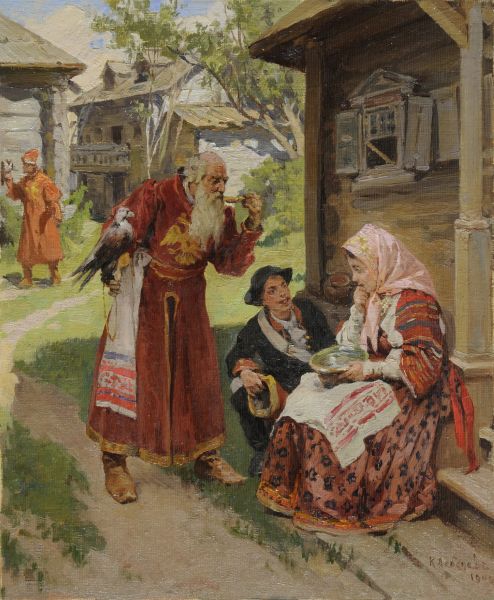|
|
Gylfalconers and Falconers Training Falcons in the Semenovsky Poteshny Yard in Moscow in the Late 17th Century. 1900

Lebedev Claudius,
Oil on cardboard
33,5 х 27
State Russian Museum
Пост.: 1930 из ГЭ (бывшее собрание Николая II)
Annotation
The 1880s and 1890s, during the reign of Alexander III, saw a growing romantic interest in a half-forgotten past and in the beauty of old folk ceremonies and court rituals. One of the largest projects in resurrecting historical memory was the 4-volume Grand Ducal, Tsarist and Imperial Hunting in Russia (published 1896–1911). Its author, Lieutenant-General Nikolai Kutepov, managed the economic aspects of Imperial hunting. He invited the most important Russian artists to illustrate the books, including Claudius Lebedev. The artist’s compositions realistically recreate the images of the people who caught and trained the birds of prey; they were the tsar’s hunters in the 17th century, the people who looked after the various falcons, hawks, gyrfalcons and other birds of prey that were kept at court.
Author's Biography
Lebedev Claudius
Lebedev, Claudius Vasilyevich
1852, Moscow (?) – 1916, Moscow
Painter, graphic artist, genre painter, illustrator, teacher. Born to a peasant family. Studied at the Stroganov School of Art and Industry (first half of the 1870s), Moscow School of Painting, Sculpture and Architecture (1875–1881). Contributed to exhibitions (from 1877). Exhibitor of the Society of Travelling Art Exhibitions (1884–1898, member from 1891), Moscow Society of Lovers of Arts (1898–1908). Taught at the Moscow School of Painting, Sculpture and Architecture (from 1890–1894), Imperial Academy of Arts (1894–1898, professor of life class). Academician (1894–1898, professor). Academician of painting (1897), full member of the Imperial Academy of Arts (from 1906). Painted icons for the iconostasis of the Bulgarian St Stephen Church in Istanbul. Illustrated Russian fairy tales, worked for magazines Pictorial Review, World Illustration and Niva.

